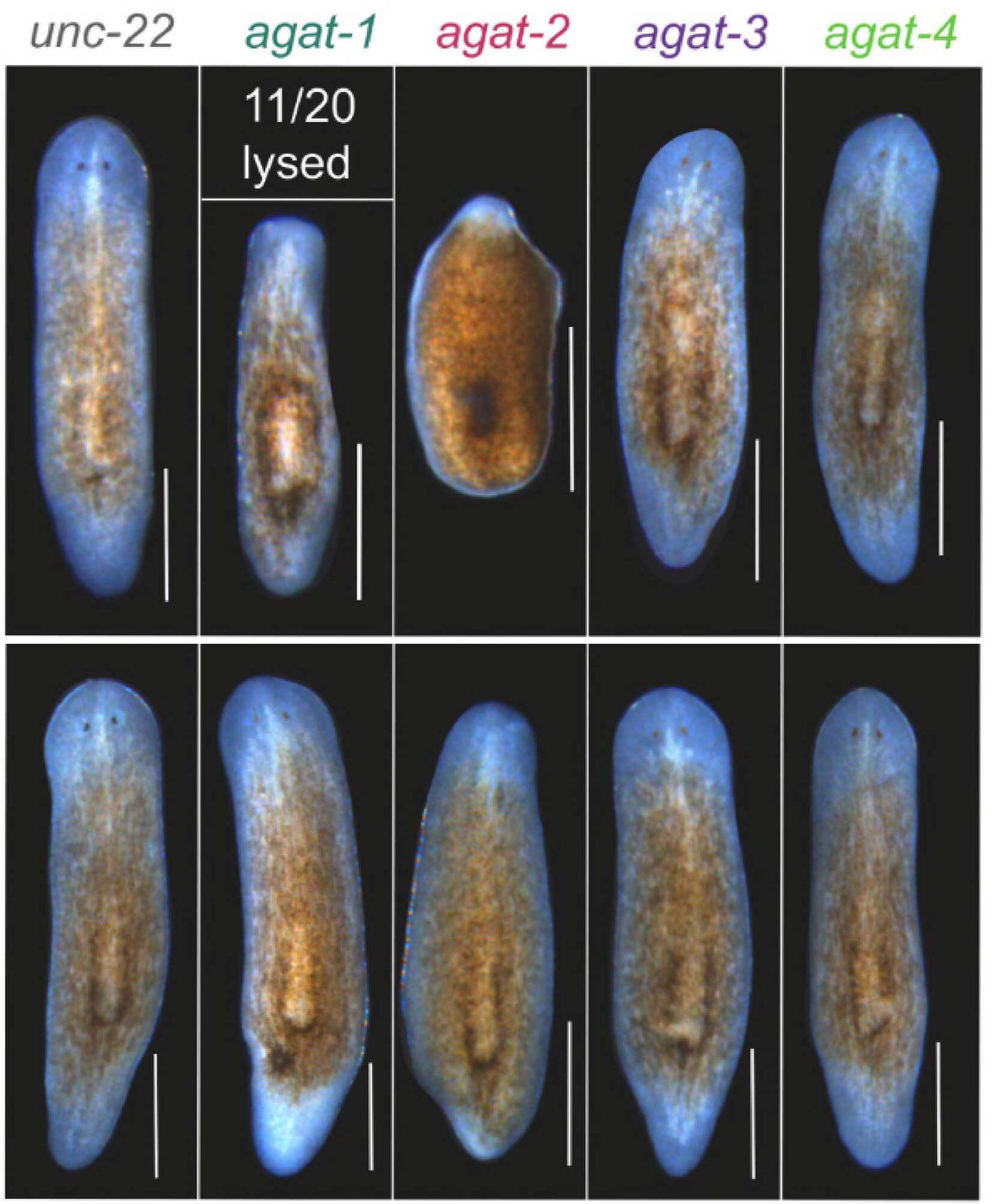The most obvious and striking difference is in this planarian’s method of movement. Typically, the underbelly of flatworms is densely populated with cilia, small hair-like projections, that beat against a secreted layer of mucus and result in a smooth, gliding motion. Girardia sp. (Guanajuato) occasionally performs the “glide,” but, more often than not, moves in an undulating, inchworm-like fashion. Scanning electron microscopy images indicated that, rather than the common uniform ciliated underbelly, the ciliation of the new flatworm resembled a desert interspersed with patches, or oases, of cilia and likely contributes to their unique form of locomotion.
Since planaria are wildly diverse, the researchers next investigated the regenerative capacity in comparison with the population of S. mediterranea maintained at the Stowers Institute. Depending on where amputation was performed with respect to the pharynx, Girardia sp. (Guanajuato) exhibited robust yet varying levels of regeneration and regeneration timing.
Planarian regeneration is in part dependent on the quantity and quality of adult stem cells present. When dosed with a lethal level of gamma radiation, Girardia sp. (Guanajuato) managed to maintain a subset of their stem cell population four times longer than S. mediterranea. While worms of similar size were chosen for the comparative study, because worm morphology and tissue density are not identical between the two species, this radiation tolerance cannot be conclusively attributed to a specialized stem cell adaptation. However, the result is sufficiently fascinating to include, particularly as it may be applicable to human cancer patients undergoing radiation therapy, particularly for those whose cancer is radiation-resistant.
Originally positioned to publish Girardia sp. (Guanajuato) as a new species of planaria was met with backlash from traditional taxonomy practices requiring evidence of reproductive structures and sexual incompatibility with other species. The worms collected from the wild largely remained asexual in the lab, however a small percentage of animals did indeed generate sex organs. Despite histological evidence of these premature organs and rigorous experimentation, the scientists’ labors did not bear any fruit, so to speak. But because of the curious nature of these worms and their uniqueness among planarian species currently in circulation in the research community, they settled on describing, and publishing, their new planarians as “isolates” of the Girardia genus.
Recently, there has been a shift to integrate the historical classification of planarian species type with classification based on molecular signatures, which could provide a pathway to reclassify the predominantly asexual isolate into a species. This is an important step for research biologists and can both facilitate comparative studies and broaden the systems used to uncover the cellular and genetic mechanisms underlying processes like regeneration.
“We want scientists to use them, to do cool biology with them because they seem to operate differently that our standard Schmidtea model and may provide important evolutionary insights,” said Nowotarski.
“They have several interesting traits that are similar yet measurably distinct from well-studied planarian species, including those with good genomic resources. This is exciting because it should make it easier for us to identify the specific gene networks that control these traits,” said Duncan.
The discovery and collection of this new isolate from central Mexico would not have been possible without the collaboration of scientists, like Sánchez Alvarado, with Clubes de Ciencia, an organization that promotes STEM courses for undergraduate students in traditionally underrepresented communities in central and South America (see list of participants below). The fruitful partnership between researchers at Stowers and the University of Guanajuato enabled a robust characterization of the unusual features of this flatworm and will hopefully inspire a new generation of scientists to pursue advanced degrees in research and to provide further clues into the secrets that make life possible.
Clubes de Ciencia México, Guanajuato, GT, México. In 2016, the Clubes de Ciencia México Workshop for Developmental Biology included: Leslie Yareli Govea-Martínez, Cristell Hernández-Fonseca, Benjamín Pérez-Sánchez, Israel Torres-Alba, Maria Ramirez-Morales, Erick Navarro-Delgado, Nohemí Carolina García-Rodríguez, Arizbeth Plascencia, José Luis Rodríguez-Ortiz, L. Gerardo Moreno-Ciénega, Adrian Maciel-Avalos, Porfirio Gallegos-Casillas, Mónica Vázquez Guerrero, Eduardo Zamudio de la Cruz, Marcos Romero-Partida, Rodrigo Jonathan Martinez-Espinosa, Abigail Zuñiga-Arenas, Sofía Quiroz Yebra, Sara Elena Ambriz-Piña, José Segoviano, Karla Fernández (undergraduate students); Fernando Longoria Vázquez (course assistant); Heather Leigh Curtis and David Angeles-Abores (course organizers).
Additional authors include Carlos Guerrero-Hernández, Eric J. Ross, Julia A. D’Orazio, Clubes de Ciencia México Workshop for Developmental Biology, Sean McKinney, PhD, Mark C. McHargue, Longhua Guo, PhD, and Melainia McClain.
This work was funded by the National Institutes of Health (awards R37 GM057260-20 and R35 GM142679), a Pilot Project award from the National Institutes of Health (award P20 GM121327), support from the Center for Teaching, Learning, & Outreach, and institutional support from the Stowers Institute for Medical Research, the Howard Hughes Medical Institute, and the University of Kentucky. The content is solely the responsibility of the authors and does not necessarily represent the official views of the NIH.





